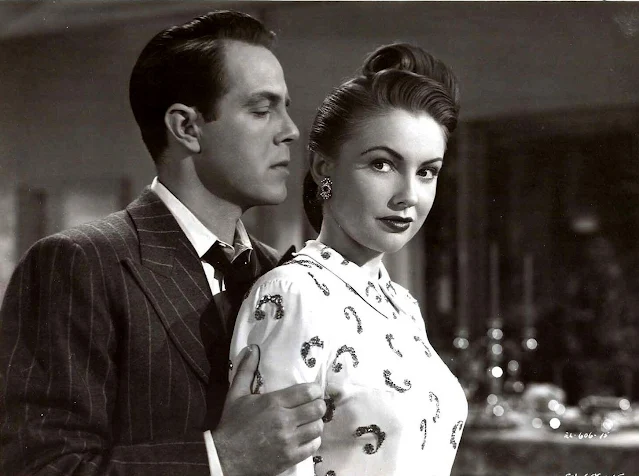 |
| Louis Hayward and Joan Leslie in Repeat Performance |
Cast: Joan Leslie, Louis Hayward, Virginia Field, Tom Conway, Richard Basehart, Natalie Schafer, Benay Venuta, Ilka Grüning. Screenplay: Walter Bullock, based on a novel by William O'Farrell. Cinematography: L. William O'Connell. Art direction: Edward C. Jewell. Film editing: Lewis Sackin. Music: George Antheil.
When Repeat Performance ended, I thought, "That was different. I wish it were better." The premise is a good one: the time loop, usually the stuff of sci-fi movies and seldom of noirish melodramas. And who hasn't wished to live a year (or day or week or month) over, knowing what you know now. That happens to Broadway star Sheila Page (Joan Leslie), who shoots her husband, a blocked playwright and alcoholic philanderer named Barney Page (Louis Hayward) just before midnight on New Year's Eve in 1946. She flees into the night, wishing that she had the year that had led up to the shooting to live over again, sure that she could prevent what had just happened. Well, sure enough she can. As New Year's Day arrives, she discovers that it's not 1947 but January 1, 1946 again. And that she's not wearing the nightgown that she threw a coat over when she ran from the apartment, but instead the new party dress she bought for New Year's. Of course, she can't convince anyone else what has happened, though she does manage to interest her Gay Best Friend, the poet William Williams (Richard Basehart), with her story that he's going to meet a woman, Eloise Shaw (Natalie Schafer), who will have him committed to a mental institution. She also knows that in the first 1946 she and Barney went to London where they met a playwright, Paula Costello (Virginia Field), who wrote the play she starred in but also started an affair with Barney. So can the past be course-corrected? Would there be a movie if it could be? What Repeat Performance needs is a somewhat better script and much better actors. Leslie doesn't make Sheila into a credible figure: She's too much the suffering wife and not enough the resourceful woman who rose to the top on Broadway. And Hayward gabbles some of the soap operatic dialogue and never shows us what Sheila saw in Barney in the first place. The best performance in the movie is Basehart, who handles the coded role of the gay man well enough to let the audience glimpse his secret life. To its credit, the screenplay handles the coding well, too, although we never find out why he was committed to the asylum: Something happened in a toy store, it seems, so maybe we're supposed to infer that William was a pedophile rather than gay. (Although in 1946, the two were often regarded as synonymous.) But despite these flaws, Repeat Performance is a watchable, if frustrating, movie.






.jpg)

